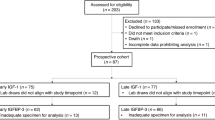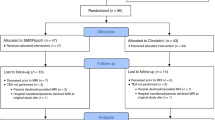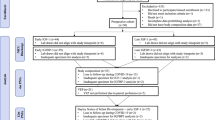Abstract
The aim of this study was to describe serum GH, IGF-I, and IGF binding protein (BP) 3 levels at birth and during the first 2 y of life in intrauterine growth-retarded (IUGR) children and to correlate these hormonal values with auxologic parameters noted during this period to investigate their predictive value on the postnatal growth pattern. Three hundred and seventeen children were included at birth and studied for auxologic and biologic parameters at birth, 3 and 30 d, and 3, 6, 12, 18, and 24 mo of age. At birth, when analyzed according to gestational age, serum GH levels were increased(p = 0.0001) and serum IGF-I and IGFBP3 levels were decreased(p = 0.0001) in IUGR as compared with normal neonates. When two cohorts were established at birth as a function of the ponderal index (PI)(≤ or >3rd percentile), serum IGF-I and IGFBP3 levels were found to be significantly reduced in the case of low PI. All parameters were within normal limits at 1 mo of age and remained normal thereafter. During the first 3 mo of life, a positive correlation was found between IGF-I increment and weight gain(r = 0.28, p = 0.002). None of the biologic parameters at birth were predictive either of later growth or of short stature at 2 y of age. In conclusion, low serum IGF-I and IGFBP3 levels at birth were related to fetal malnutrition and were not predictive parameters for later growth.
Similar content being viewed by others
Log in or create a free account to read this content
Gain free access to this article, as well as selected content from this journal and more on nature.com
or
Notes
Study Group of IUGR includes pediatric clinics: Y. Aujard, M. Berterottière, C. Boissinot, A. Decrepy, A. Fjellestad Paulsen, C. Fondacci, J. C. Gabilan, C. Lejeune, E. Mugnier, C. Nessmann, D. Porquet, J. M. Retbi, J. C. Ropert, I. Thizon de Gaulle, and M. Vial (Paris); C. Bouderlique, G. Champion and M. G. Joseph (Angers); and B. Leheup, M. Pierson, J. Pochard, and J. Vert (Nancy).
Abbreviations
- IGFBP3:
-
IGF-binding protein 3
- IUGR:
-
intrauterine growth retardation
- SDS:
-
SD score
- PI:
-
ponderal index
References
Deiber M, Chatelain P, Naville D, Putet G, Salle G 1989 Functional hypersomatotropism in small for gestational age newborn infants. J Clin Endocrinol Metab 68: 232–234
De Zegher F, Kimpen J, Raus J, Vanderschueren-Lodeweyckx M 1990 Hypersomatotropism in the dysmature infant at term and preterm birth. Biol Neonate 58: 188–191
Foley JP, De Philip R, Perricelli A, Miller A 1980 Low somatomedin activity in cord serum from infants with intrauterine growth retardation. J Pediatr 96: 605–610
Thieriot-Prevost G, Daffos F, Forestier F 1985 Serum somatomedin C and bioassay able growth promoting activity (thymidine activity) in appropriate and small for gestational age human newborns. Acta Endocrinol 110: 32–35
Verhaeghe J, Van Bree R, Van Herck EV, Laureys J, Bouillon R, Van Assche A 1993 C-Peptide, insulin-like growth factors I and II and insulin-like growth factor binding protein-1 in umbilical cord serum: correlations with birth weight. Am J Obstet Gynecol 169: 89–97
Giudice LC, De Zegher F, Gargosky SE, Dsupin BA, Fuentes DL, Crystal RA, Hitz RL, Rosenfeld RG 1995 Insulin-like growth factors and their binding proteins in the term and preterm human fetus and neonate with normal and extremes of intrauterine growth. J Clin Endocrinol Metab 80: 1548–1555
Samaan NA, Schultz PN, Johnston DA, Creasy RW, Gonik B 1987 Growth hormone, somatomedin C, and nonsuppressible insulin-like activity levels compared in premature, small, average birth weight and large infants. Am J Obstet Gynecol 157: 1524–1528
Thieriot-Prevost G, Boccara JF, Francoual C, Badoual J, Job JC 1988 Serum insulin-like growth factor 1 and serum growth-promoting activity during the first postnatal year in infants with intrauterine growth retardation. Pediatr Res 24: 380–383
Wang HS, Lim J, English J, Irvine L, Chard T 1991 The concentration of insulin-like growth factor I and insulin-like growth factor binding protein 1 in human umbilical cord serum at delivery: relation to fetal weight. J Endocrinol 129: 459–464
Varvarigou A, Vagenakis AG, Makri M, Beratis NG 1994 Growth hormone, insulin-like growth factor I and prolactin in small for gestational age neonates. Biol Neonate 65: 94–102
Leroy B, Lefort FA 1971 A propos du poids et de la taille des nouveau-nes a la naissance. Rev Fr Gynecol Obstet 66: 391–396
Largo RH, Wälli R, Duc G, Fanconi A, Prader A 1980 Evaluation of perinatal growth. Helv Paediatr Acta 35: 419–436
Sempe M, Pedron G, Roy-Pernot MP 1979 Auxologie, methodes et séquences Theraplix, Paris
Miller HC, Hassanein K 1971 Diagnosis of impaired fetal growth in newborn infants. Pediatrics 48: 511–522
Rolland Cachera MF, Cole TJ, Sempe M, Tichet J, Rossignol C, Charraud A 1991 Body mass index variation centiles from birth to 87 years. Eur J Clin Nutr 45: 13–21
Binoux M, Seurin D, Lassare C, Gourmelen M 1984 Preferential measurements of insulin-like growth factor (IGF-I) related peptides in serum with the aid of IGF binding proteins (IGFBP3) produced by rat liver in culture: estimation of serum IGFBP levels. J Clin Endocrinol Metab 59: 453–462
Blum WF, Ranke MB, Kietzmann K, Gaugel HJ, Zeisel HJ, Bierich JR 1990 A specific radio-immunoassay for the growth hormone (GH) dependent somatomedin binding protein: its use for diagnosis of GH deficiency. J Clin Endocrinol Metab 70: 1292–1298
Lassare C, Hardouin S, Daffos F, Forestier F, Frankenne F, Binoux M 1991 Serum insulin-like growth factor binding proteins in the human fetus. Relationships with growth in normal subjects and in subjects with intrauterine growth retardation. Pediatr Res 29: 219–225
Bang P, Westgren M, Schwanger J, Blum WF, Rosenfeld RG, Stangenberg M 1994 Ontogeny of insulin-like growth factor binding protein 1, 2, and 3: quantitative measurements by radioimmunoassay in human fetal serum. Pediatr Res 36: 528–536
De Zegher F, Devlieger H, Veldhuis JD 1993 Properties of growth hormone and prolactin hypersecretion by the human infant on the day of birth. J Clin Endocrinol Metab 76: 1177–1181
Kao PC, Matheny AP, Lang CA 1994 Insulin-like growth factor 1 comparisons in healthy twin children. J Clin Endocrinol Metab 78: 310–312
Bennett A, Wilson DM, Liu F, Nagashima F, Rosenfeld RG, Hintz RI 1983 Levels of insulin-like growth factors I and II in human cord blood. J Clin Endocrinol Metab 57: 609–612
Gluckman PD, Johnson-Barrett JJ, Butler JH, Edgar BW, Gunn TR 1983 Studies of insulin-like growth factor I and II by specific radioligand assays in umbilical cord blood. Clin Endocrinol 19: 405–413
Bernstein IM, De Souza MM, Copeland KC 1991 Insulin-like growth factor I in substrate deprivated growth retarded fetal rats. Pediatr Res 30: 154–157
Strauss DS, Ooi GT, Orlowski CC, Rechler MM 1991 Expression of the genes for insulin-like growht factor I (IGFI), IGFII and IGF binding protein 1 and 2 in fetal rat under conditions of intrauterine growth retardation caused by maternal fasting. Endocrinology 128: 518–525
Vileisis RA, D'Ercole AJ 1986 Tissue and serum concentrations of somatomedin C/insulin-like growth factor I in fetal rats made growth retarded by uterine artery ligation. Pediatr Res 20: 126–130
Unterman TG, Simmons RA, Glick RP, Ogata ES 1993 Circulating levels of insulin, insulin-like growth factor I (IGFI), IGF II and IGF binding proteins in the small for gestational age fetal rat. Endocrinology 132: 327–336
Gluckman PD, Butler JH, Comline R, Fowden A 1987 The effects of pancreatectomy on the plasma concentrations of insulin-like growth factors 1 and 2 in the sheep fetus. J Dev Physiol 9: 79–88
Jones CT, Gu W, Harding JE, Prile DA, Parer JT 1988 Studies on the growth of fetal sheep. Effects of surgical reduction in placental size or experimental manipulation of uterine blood flow on plasma sulphation promoting activity and on the concentrations of insulin-like growth factors I and II. J Dev Physiol 10: 179
Crystal RA, Giudice LC 1991 Insulin-like growth factor binding protein (IGFBP) profiles in human fetal cord sera: ontogeny during gestation and differences in newborns with intra-uterine growth retardation(IUGR) and large for gestation age (LGA) newborns. In Spencer EM (ed) Modern Concepts of Insulin-like Growth Factors. Elsevier, New York, pp 395–408
Massa G, De Zegher F, Vanderschueren-Lodeweyckx M 1992 Serum growth hormone binding proteins in the human fetus and infant. Pediatr Res 32: 69–72
Halmesmäki E, Välimäki M, Karonen SL, Ylikorkala O 1989 Low somatomedin C and high growth hormone levels in newborns damaged by maternal alcohol abuse. Obstet Gynecol 74: 366–70
Beratis NG, Varvarigou A, Makri M, Vagenakis AG 1994 Prolactin, growth hormone and insulin-like growth factor 1 in newborn children of smoking mothers. Clin Endocrinol 40: 179–85
Clemmons DR, Underwood LE 1991 Nutritional regulation of IGF-I and IGF binding proteins. Annu Rev Nutr 11: 393–412
De Waal WJ, Hokken-Koelega ACS, Stijnen Th, De Muinck Keizer Schrama SMPF, Drop SLS and the Dutch Working Group on Growth Hormone 1994 Endogenous and stimulated GH secretion, urinary GH excretion and plasma IGFI and IGFII levels in prepubertal children with short stature after intrauterine growth retardation. Clin Endocrinol 41: 621–630
Donovan HM, Oh Y, Pham H, Rosenfeld RG 1989 Ontogeny of serum insulin-like growth factor binding protein in the rat. Endocrinology 125: 2621–2627
Hardouin S, Gourmelen M, Noguiez P, Seurin D, Roghani M, Leboul Y, Povoa G, Merimee TJ, Hossenlopp P, Binoux M 1989 Molecular forms of serum insulin-like growth factor (IGF). Binding proteins in man: relationships with growth hormone and IGF and physiological significance. J Clin Endocrinol Metab 69: 1291–1301
Hasegawa Y, Hasegawa T, Aso T, Kotoh S, Tsuchiya Y, Nose O, Ohyama Y, Araki K, Tanaka T, Saisyo S, Yokoya S, Nishi Y, Miyamoto S, Sasaki N, Kurimoto F, Toyama M, Harada A, Horie H, Stene M 1993 Comparaison between insulin-like growth factor I (IGFI) and IGF binding protein 3 (IGFBP3) measurement in the diagnosis of growth hormone deficiency. Endocr J 40: 185–190
Acknowledgements
The authors thank C. Limoni for the statistical analyses.
Author information
Authors and Affiliations
Additional information
JULIANE LEGER, MICHÈLE NOEL, JEAN MARIE LIMAL, PAUL CZERNICHOW, on behalf of the Study Group of IUGRFootnote 1
Supported by Serono Laboratories.
This work was presented in part at the Fourth Joint Meeting of the Lawson Wilkins Pediatric Endocrine Society and the European Society for Paediatric Endocrinology, San Francisco, CA, 1993.
Rights and permissions
About this article
Cite this article
Leger, J., Noel, M., Limal, J. et al. Growth Factors and Intrauterine Growth Retardation. II. Serum Growth Hormone, Insulin-Like Growth Factor (IGF) I, and IGF-Binding Protein 3 Levels in Children with Intrauterine Growth Retar Age. Pediatr Res 40, 101–107 (1996). https://doi.org/10.1203/00006450-199607000-00018
Received:
Accepted:
Issue date:
DOI: https://doi.org/10.1203/00006450-199607000-00018
This article is cited by
-
Prevalence of children born small for gestational age with short stature who qualify for growth hormone treatment
Italian Journal of Pediatrics (2021)
-
Incidence and Neonatal Risk factors of Short Stature and Growth Hormone treatment in Japanese Preterm Infants Born Small for Gestational Age
Scientific Reports (2019)
-
Growth Patterns in Small for Gestational Age Babies and Correlation with Insulin-like Growth Factor-1 Levels
Indian Pediatrics (2018)
-
11p15 DNA-methylation analysis in monozygotic twins with discordant intrauterine development due to severe twin-to-twin transfusion syndrome
Clinical Epigenetics (2014)
-
Critical periods of increased fetal vulnerability to a maternal high fat diet
Reproductive Biology and Endocrinology (2014)



